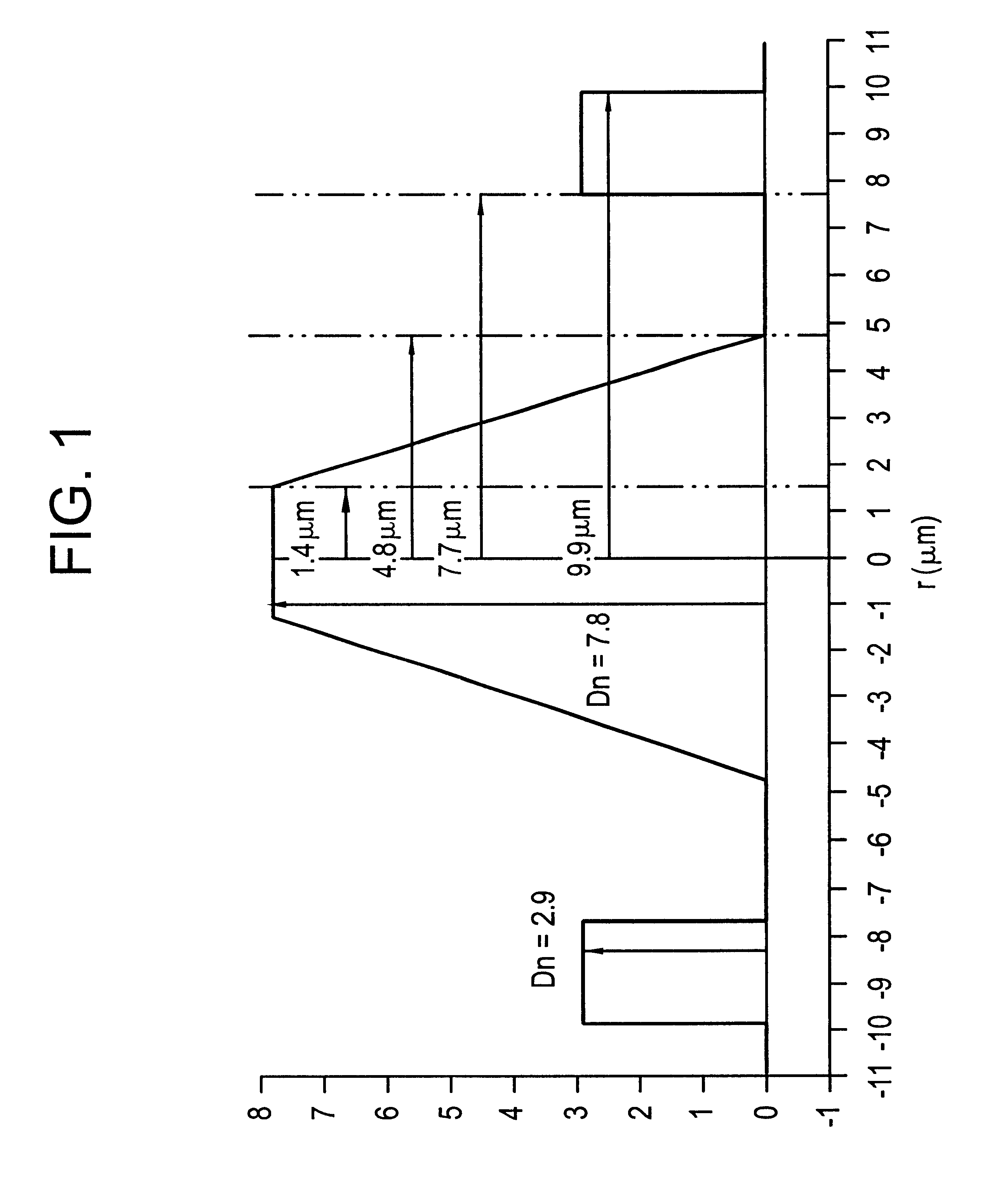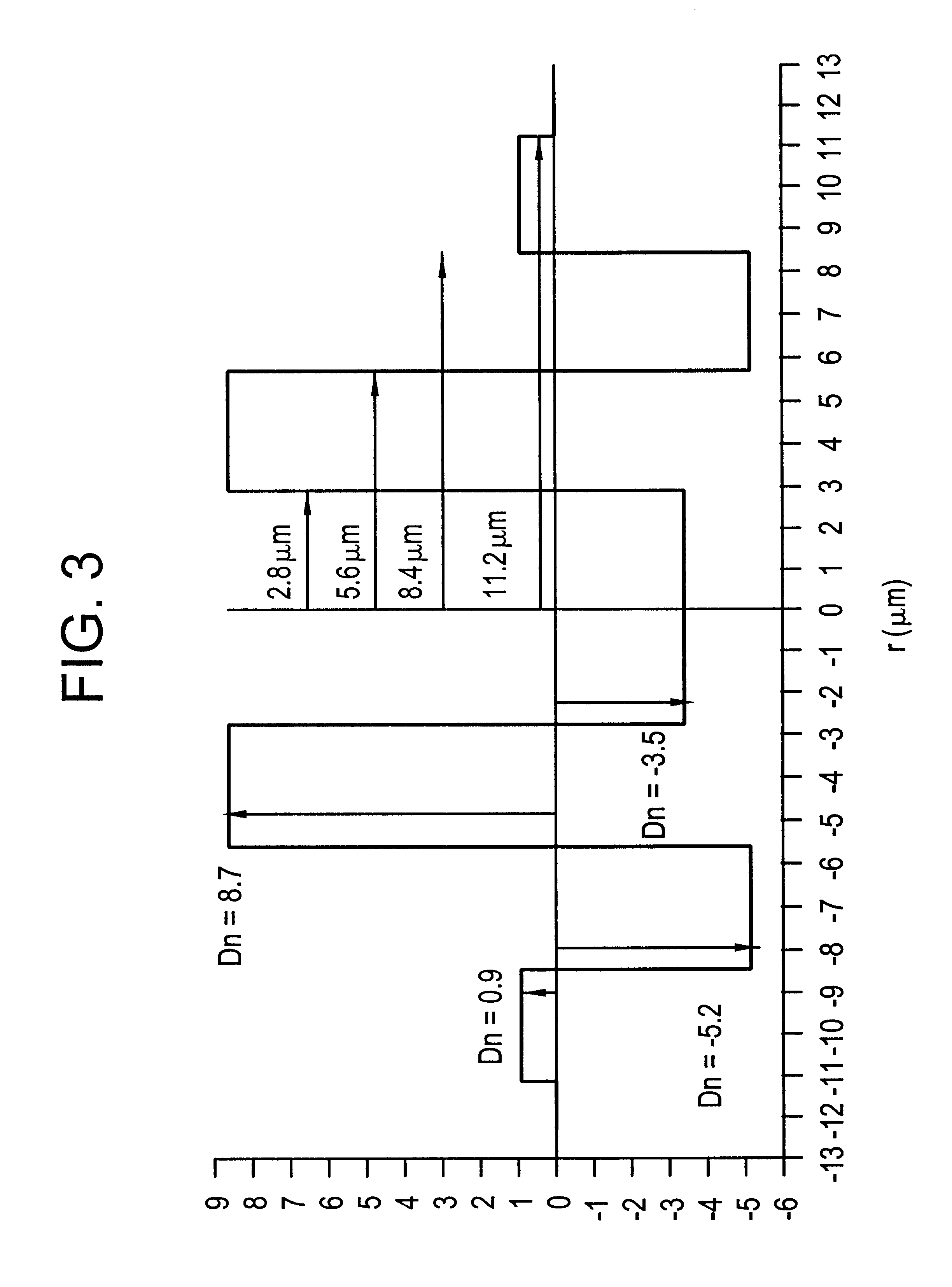Line fiber for WDM optical fiber transmission systems
a transmission system and optical fiber technology, applied in the direction of optical fiber with multi-layer core/cladding, optical waveguide light guide, instruments, etc., can solve the problems of difficult operation of the transmission system under realistic conditions, high cost of fiber, and configuration suffers from the drawback of cost nearly double, so as to increase the channel data rate and keep the system cost down.
- Summary
- Abstract
- Description
- Claims
- Application Information
AI Technical Summary
Benefits of technology
Problems solved by technology
Method used
Image
Examples
first embodiment
FIG. 1 is a diagram of the index profile of a fiber constituting the invention; in this embodiment, the index profile is a trapezoid type index profile with a ring, and it presents, starting from the center of the fiber:
a central portion having a refractive index greater than that of the cladding; and
a first annular portion in which the index decreases in substantially linear manner;
the fiber as a whole constituting a fiber having a so-called "trapezoid" profile.
Around this first annular portion, the fiber has a portion of substantially constant index, followed by a second annular portion of index greater than that of the cladding, forming a ring about the trapezoid profile.
The values for the indices and the radii in the embodiment of FIG. 1 are as follows. The central portion has a radius r.sub.1 of 1.4 .mu.m and its index differs from the index of the cladding by .DELTA.n.sub.1 equal to 7.8.times.10.sup.-3.
The index decreases in substantially linear manner to go from the value .DE...
second embodiment
FIG. 2 is a diagram of the index profile of a fiber constituting the invention. In this embodiment, the index profile is a trapezoid type index profile having buried cladding with a ring. In other words, compared with the profile of FIG. 1, the substantially constant index portion surrounding the trapezoid has an index smaller than the index of the fiber cladding. The profile of FIG. 2 is described using the same notation as used for FIG. 1 concerning radii and indices.
The geometrical characteristics of the profile of FIG. 2 are as follows:
r.sub.1 =3.0 .mu.m
r.sub.2 =5.0 .mu.m
r.sub.3 =5.9 .mu.m
r.sub.4 =8.4 .mu.m
.DELTA.n.sub.1 =6.6
.DELTA.n.sub.3 =-5.0
.DELTA.n.sub.4 =3.6
These values make it possible to obtain a fiber having the following characteristics:
a theoretical cutoff wavelength .lambda..sub.cth : 1620 nm;
a chromatic dispersion canceling wavelength .lambda..sub.0 : 1410 nm;
chromatic dispersion slope at 1550 nm: 0.055 ps / (nm.sup.2.km);
chromatic dispersion at 1550 nm: 8 ps / (nm.km);...
sixth embodiment
FIG. 6 is a diagram showing the index profile of a fiber constituting the invention. The profile of FIG. 6 is a coaxial profile, surrounded by a buried portion. Starting from the center, the fiber has:
a central portion of substantially constant index;
an annular portion of index greater than the index of the cladding, and also greater than the index of the central portion; and
a buried portion of index smaller than the index of the cladding.
The index and radius values given in the embodiment of FIG. 6 are as follows. The central portion has a radius r.sub.1 of 2.4 .mu.m and its index differs from the index of the cladding by .DELTA.n.sub.1 =-5.9.times.10.sup.-3.
The annular portion extends between the radius r.sub.1 and the radius r.sub.2 =5.3 .mu.m, and its index differs from that of the cladding by .DELTA.n.sub.2 =9.2.times.10.sup.-3.
The buried portion extends from radius r.sub.2 to radius r.sub.3 =8.4 .mu.m. Compared with the index of the cladding, its index differs by .DELTA.n.sub....
PUM
 Login to View More
Login to View More Abstract
Description
Claims
Application Information
 Login to View More
Login to View More - R&D
- Intellectual Property
- Life Sciences
- Materials
- Tech Scout
- Unparalleled Data Quality
- Higher Quality Content
- 60% Fewer Hallucinations
Browse by: Latest US Patents, China's latest patents, Technical Efficacy Thesaurus, Application Domain, Technology Topic, Popular Technical Reports.
© 2025 PatSnap. All rights reserved.Legal|Privacy policy|Modern Slavery Act Transparency Statement|Sitemap|About US| Contact US: help@patsnap.com



